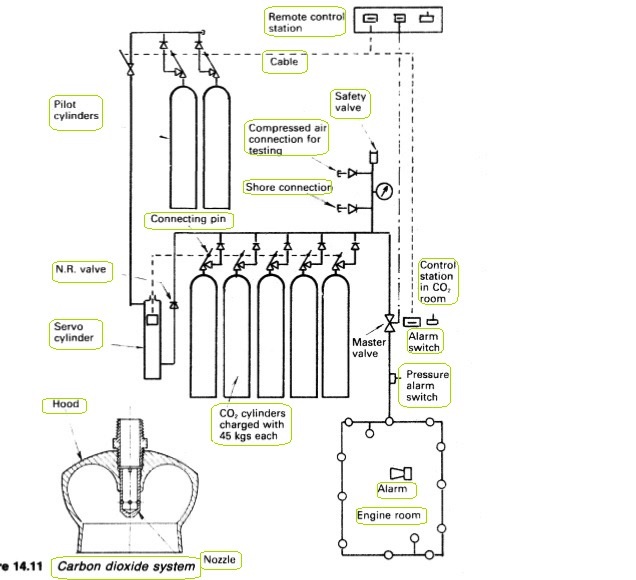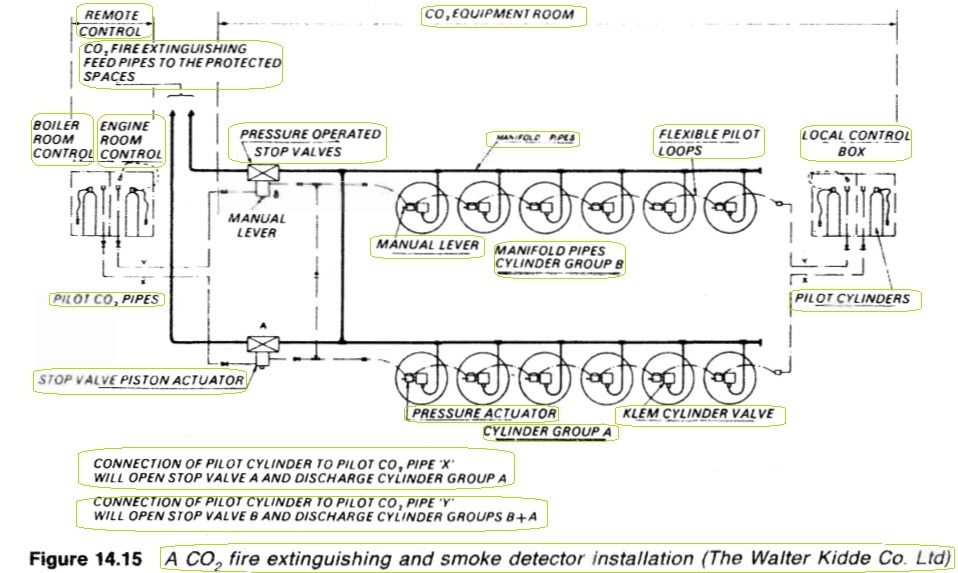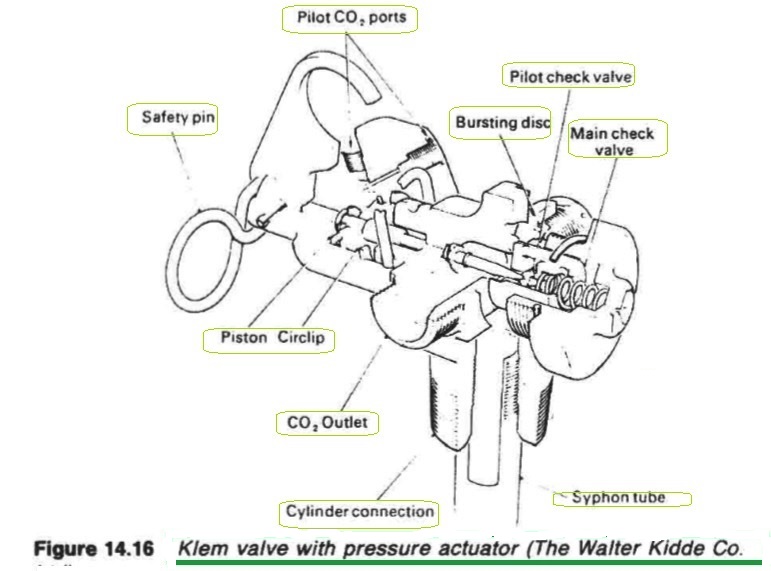
Home page||Fire protection||
Machinery space fire protection methods & Walter Kidde CO2 system
Machinery spaces are protected by fixed fire extinguishing installations, the
fire main and extinguishers. Any statutory fixed installation must be operable
from a position outside of the space. Any emergency stops for machinery and
vent fans, means of securing openings and fuel tank valve shut-off devices,
must also be located external to the space.
Machinery space fires
Engine room fires have been started by neglected oil leaks with the
combustible material, in the form of fuel or lubricating oil dripping on to and
being ignited by hot exhaust manifolds. There are a number of examples of
combustible materials and potential ignition sources in machinery spaces. A
fire when it starts is usually small enough to be dealt with by a vigilant
watchkeeper using a portable fire extinguisher.
A fire which develops
undetected in an unmanned machinery space (or one where the watchkeeper is
in a control room) could require complete shutdown, evacuation and
employment of the inert gas system. With unmanned spaces, an efficient alarm
system for early detection is vital

Figure : Carbon dioxide system

Figure : Cargo ship fire main (R. C. Dean)
Walter Kidde CO2 system
Figure 14.15 is a schematic layout of a Walter Kidde CO2 system in which pilot
CO2 cylinders are used to open the distribution system main stop valve and
subsequently the valves on the individual cylinders.
The system shown has
two banks of cylinders. The pilot CO2 cylinders are contained in a control box
and normally disconnected. To operate the system a flexible pipe fitted with a
quick action coupling is plugged into a corresponding socket. When the valve
on the pilot cylinder is opened the pilot CO2 will open the system main stop
valve.
The stop valve actuator is a piston device and when the piston is fully
depressed a second port is exposed which allows the pilot gas to flow to the
CO2 cylinder bank and to operate the cylinder valves. As soon as the control
cabinet door is opened to do this, the alarm is initiated. The position of the
hoses in the quick-coupling housings prevents the door from being closed.
The pilot CO2 cylinders and the main CO2 cylinders for this system, are
fitted with Klem valves.
An isometric sketch of a Klem valve fitted with a CO2
actuator is shown in Figure 14.16. The safety pin shown is for transporting the
cylinders. When installed the safety pins are removed from the valves,
allowing them to be operated manually or by pilot pressure. As soon as
mechanical or pilot pressure is removed, the valve will close again. In this
system each of the cylinders is fitted with a CO2 operated actuator.

Figure : CO2 fire extinguishing installation

Figure :Klem valve with pressure actuator
Summarized below general cargo ship fire protection equipments & guideline:
- Fire main system & related mechanism
The fire main
extends to the full length of the ship and from the machinery spaces to the
highest levels. Hydrants served by the main, are situated so that with suitable
hoses any area on the ship can be reached.
.....more
- CO2 fire extinguishing installation
Fire extinguishing installations employing CO2 stored under pressure at
ambient temperature are extensively used to protect ships' cargo compartments,
boiler rooms and machinery spaces. When released the CO2 is distributed
throughout the compartment, so diminishing the relative oxygen content and
rendering the atmosphere inert.
...... more
- Fire fighting equipments
Two independently powered pumps must be provided in all cargo ships of 1000 tons gross and over and in passenger ships of less than 4000 tons gross. Larger passenger vessels and passenger ferries must have three such pumps. The pumps are fitted with non-return valves if they are of the centrifugal type, to prevent loss of water back through open valves when not running.
..... more
- Details of fire detectors
A variety of devices are available for detecting fire in unmanned machinery
spaces but each has an ability to detect basically only one aspect. Thus, smoke
detectors based on the ionization chamber are able to recognize combustion
products but will not register radiation from a flame or heat.
.....more
- Machinery space fire & use of Walter Kidde CO2 system
Walter Kidde CO2 system employs pilot
CO2 cylinders to open the distribution system main stop valve and
subsequently the valves on the individual CO2 cylinders.
.....more
- Fire protection system for cargo holds
Holds for general cargo, have been protected against fire by fixed installations which deliver inert gas from an inert gas generator based on combustion of fuel (similar to the system available for inerting oil tankers) and halon systems.
.....more
- Low pressure CO2 storage
In some installations, the CO2 is stored in low pressure refrigerated tanks. The
cylindrical storage vessels are fabricated to the pressure vessel
requirements of the authorities. The tanks are of low temperature steel, fully
tested and stress relieved. They are mounted on supports designed to
withstand shock from collision.
..... more
- Halon system
Halon 1301 has the chemical formula CF3 Br being known as bromo-trifluoromethane.
It is a colourless, odourless gas with a density five times that of air and
extinguishes fire by breaking the combustion chain reaction.
.....more
- Multi-spray system for the machinery spaces
This system is similar to the sprinkler used in accommodation areas but the spray heads are not operated automatically. The section control valves (Figure 14.20) are opened by hand to supply water to the heads in one or more areas. Ready to use hoses can also be supplied. Fresh water is used for the initial charging and the system is brought to working pressure by means of the compressed air connection.
.....more
- Automatic sprinkler system
A network of
sprinkler heads is arranged throughout the spaces to be protected. Each sprinkler head is normally kept closed by a quartzoid bulb which is almost filled with a liquid having a high expansion ratio.
.....more
- Details various portable extinguishers & how to use ?
The first line of defence against fire in any area of the ship, is the portable fire extinguisher. Some common portable extinguishers that have been used at sea are described.
.....more
Home page||Cooling ||Machinery||Services ||Valves ||Pumps ||Auxiliary Power ||Propeller shaft ||Steering gears ||Ship stabilizers||Refrigeration||Air conditioning ||Deck machinery||Fire protection||Ship design
||Home ||
General Cargo Ship.com provide information on cargo ships various machinery systems -handling procedures, on board safety measures and some basic knowledge of cargo ships that might be useful for people working on board and those who working in the terminal. For any remarks please
Contact us
Copyright © 2010-2016 General Cargo Ship.com All rights reserved.
Terms and conditions of use
Read our privacy policy|| Home page||



